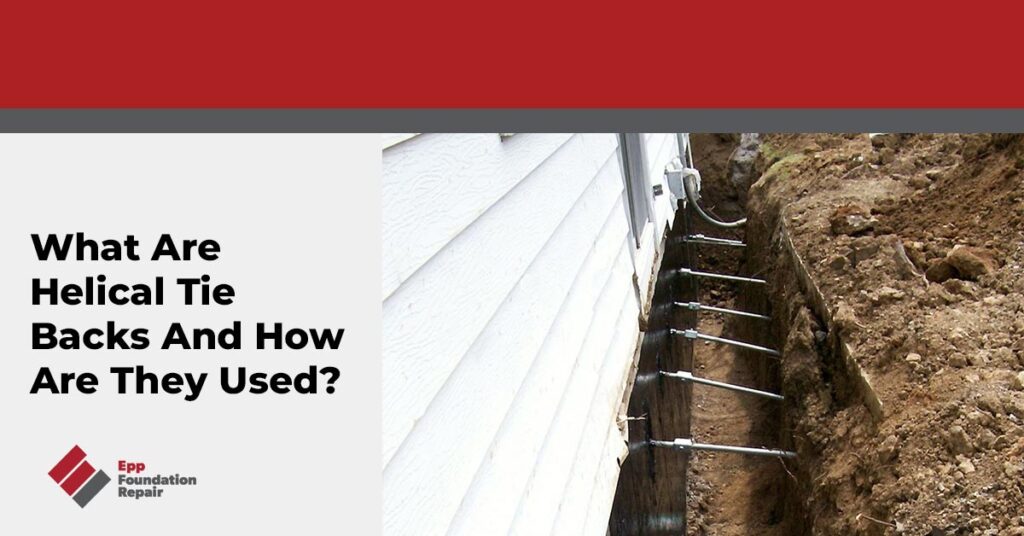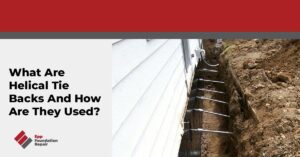Looking for information about helical tiebacks? If so, don’t hit that back button because you’ve landed on the right page. In this article, we’re going to cover helical tiebacks, what they’re used for, how they differ from wall anchors, and how they’re installed.
What Are Helical Tieback Anchors?
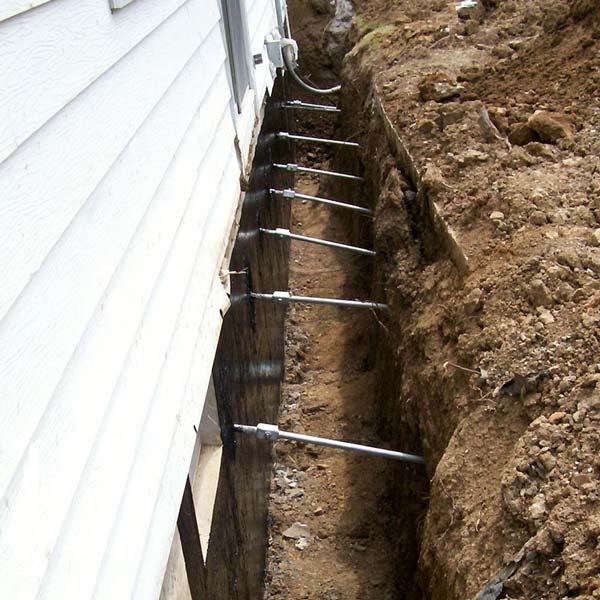
Helical tieback anchors are essentially helical piers that provide lateral support to existing structures.
The helical tieback anchor system consists of a helical pier and a load-transfer bracket that connects the pier to the structure it intends to support. The helical pier and the load-transfer bracket are made of high-grade steel that has been heat-treated for maximum strength and durability.
Helical tieback anchors offer immediate wall stabilization without having to excavate the soil around the foundation because they’re installed from inside the basement. However, helical tiebacks are difficult to install. This is their main drawback.
Where Are Helical Tiebacks Used?
Helical tiebacks are just one solution for bowed and/or cracked basement walls experiencing lateral pressure. Yes, they can be installed from inside the basement without excavation. However, it’s not a quick job and the installation is difficult. This is why we almost always use I-beams, wall plate anchors, or carbon fiber straps to stabilize a bowing and/or cracked basement wall.
Helical tiebacks are also used to anchor retaining walls. The tiebacks resist the lateral forces exerted against the wall by soil and water.
How Do Helical Tiebacks Differ From Wall Plate Anchors?
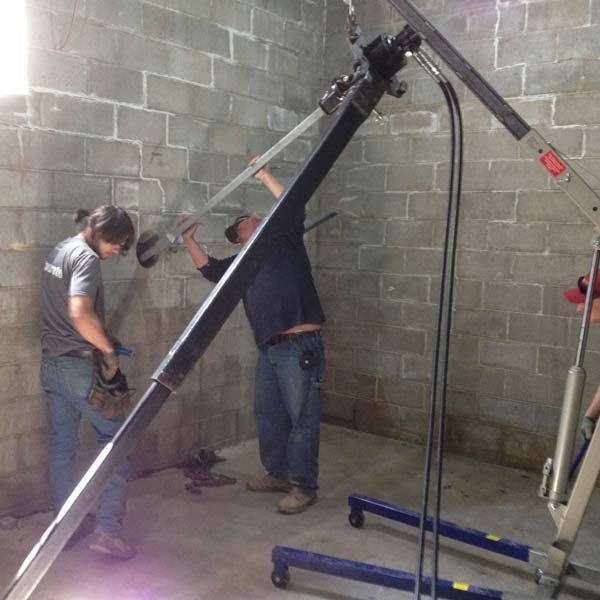
Helical tiebacks and wall plate anchors are two different methods to support and stabilize bowed and/or cracked basement walls.
Helical tiebacks
Helical tiebacks, also known as screw anchors, are helical piers drilled deep into the soil behind a wall at an angle and then screwed into place. Helical tiebacks are designed to provide lateral support to the wall by transferring the weight and loads from the wall to the soil. They’re used for repairing bowing or leaning walls and can be used in various soil conditions.
Wall plate anchors
Wall plate anchors also resist forces that could cause the wall to bow inward and crack, such as hydrostatic pressure and frost heave. A wall plate anchor system is an anchor buried in the ground outside the foundation wall that’s attached to steel plates on the inside of the basement wall using steel rods or cables.
To install the anchors, the ground around the foundation will need to be dug up so they can be buried in the yard. The anchor is then connected to the steel rod/cable that goes through the wall and attaches to the steel plate on the inside of the basement wall. Once the system is in place, the anchor can be tightened, stabilizing the wall and preventing further movement.
How Are Helical Tiebacks Installed?
The general procedure for installing helical tiebacks is as follows:
- First, holes (10-12’’ in diameter, minimum) are drilled through the wall at a slight downward angle. These holes should be spaced evenly along the length of the wall where the tiebacks will be installed.
- Next, the helical piers(i.e., tiebacks) are screwed into each hole while a hydraulic torque motor rotates them. The helical piers are designed to grip the soil on the other side of the wall, creating a secure anchor point.
During installation, it’s essential to carefully monitor the torque applied to the helical piers. This ensures they’re being installed at the correct depth and with the appropriate level of tension, which is necessary for effective wall reinforcement.
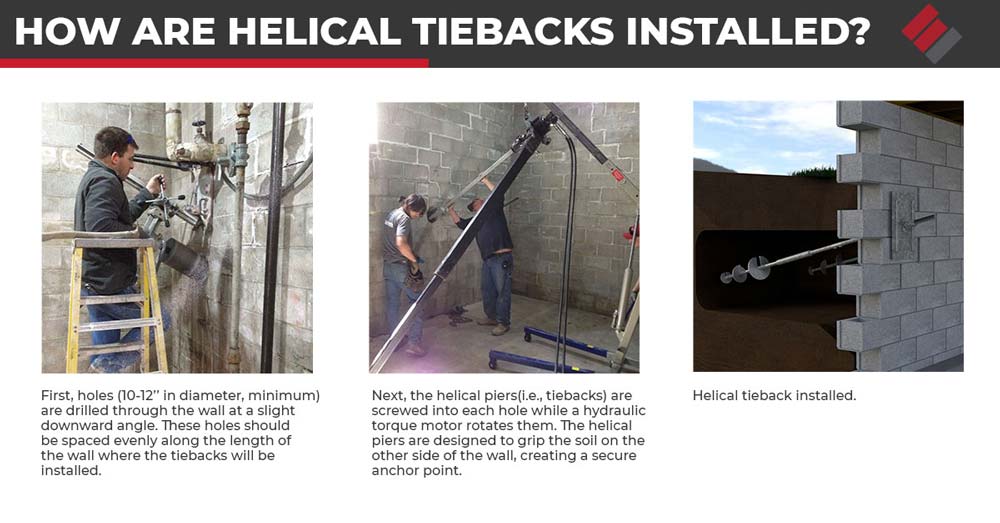
How To Prevent Bowed, Cracked Basement Walls
While helical tiebacks are one solution – and not the best one, in our opinion – for stabilizing a bowed and/or cracked basement wall, avoiding the problem is even better. Bowed and/or cracked basement walls compromise the home’s foundation and the safety of anyone living in the house. To prevent these problems from occurring, you’ll need to control groundwater around the foundation. This can be achieved by taking a few simple yet effective measures.
- Homeowners should prioritize cleaning their gutters regularly. This ensures water is directed away from the foundation and doesn’t accumulate around the basement walls. Overflowing gutters can result in water seeping into the foundation and causing structural damage.
- Installing downspout extensions can also help prevent basement wall damage by directing water away from the house before release.
- Re-grading the yard is another preventative measure that can be taken if necessary. If the yard slopes towards the house, water can accumulate around the foundation and cause trouble. Re-grading the yard so that it slopes away from the house will allow water to drain away from the foundation.
- Finally, installing a drain tile system is the best foundation waterproofing method available today. This system involves installing a perforated pipe around the foundation, which is then covered with gravel. The pipe redirects water away from the foundation and towards a sump pit. When the pit fills with water, a sump pump turns on and ejects the water a safe distance from the foundation. This system is highly effective in preventing basement wall damage, as it ensures that any water accumulated around the foundation is quickly and efficiently removed. For more information, see Basement Drain Systems: The Secret To A Dry Basement.
If you have a bowed and/or cracked basement wall – or a retaining wall – that might need stabilization and reinforcement, contact us today to schedule an evaluation. We serve areas in Nebraska, Iowa, Kansas, and Missouri.

